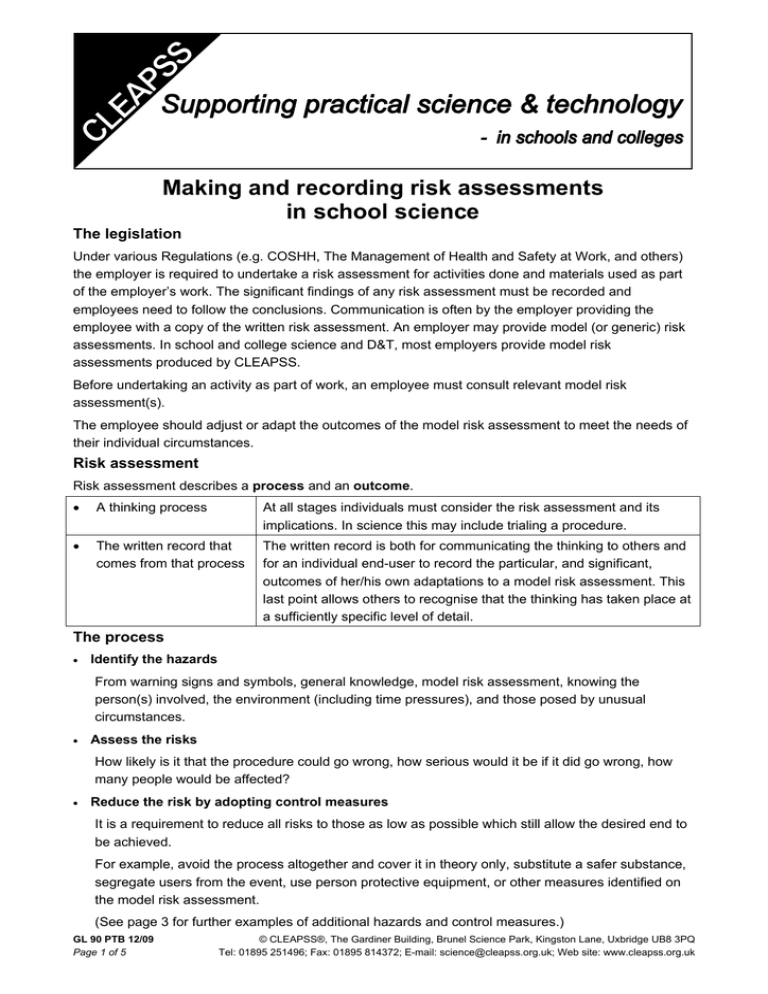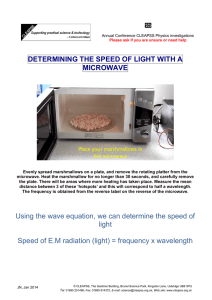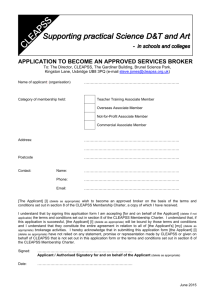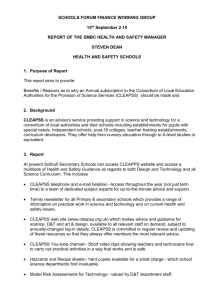Making and recording risk assessments in school science The legislation
advertisement

Making and recording risk assessments in school science The legislation Under various Regulations (e.g. COSHH, The Management of Health and Safety at Work, and others) the employer is required to undertake a risk assessment for activities done and materials used as part of the employer’s work. The significant findings of any risk assessment must be recorded and employees need to follow the conclusions. Communication is often by the employer providing the employee with a copy of the written risk assessment. An employer may provide model (or generic) risk assessments. In school and college science and D&T, most employers provide model risk assessments produced by CLEAPSS. Before undertaking an activity as part of work, an employee must consult relevant model risk assessment(s). The employee should adjust or adapt the outcomes of the model risk assessment to meet the needs of their individual circumstances. Risk assessment Risk assessment describes a process and an outcome. • A thinking process At all stages individuals must consider the risk assessment and its implications. In science this may include trialing a procedure. • The written record that comes from that process The written record is both for communicating the thinking to others and for an individual end-user to record the particular, and significant, outcomes of her/his own adaptations to a model risk assessment. This last point allows others to recognise that the thinking has taken place at a sufficiently specific level of detail. The process • Identify the hazards From warning signs and symbols, general knowledge, model risk assessment, knowing the person(s) involved, the environment (including time pressures), and those posed by unusual circumstances. • Assess the risks How likely is it that the procedure could go wrong, how serious would it be if it did go wrong, how many people would be affected? • Reduce the risk by adopting control measures It is a requirement to reduce all risks to those as low as possible which still allow the desired end to be achieved. For example, avoid the process altogether and cover it in theory only, substitute a safer substance, segregate users from the event, use person protective equipment, or other measures identified on the model risk assessment. (See page 3 for further examples of additional hazards and control measures.) GL 90 PTB 12/09 Page 1 of 5 © CLEAPSS®, The Gardiner Building, Brunel Science Park, Kingston Lane, Uxbridge UB8 3PQ Tel: 01895 251496; Fax: 01895 814372; E-mail: science@cleapss.org.uk; Web site: www.cleapss.org.uk What you need to record CLEAPSS believes that the significant findings of any risk assessment procedure are best recorded on documents in daily use, such as a scheme of work, lesson plans, worksheets and technician’s notes. • • • Record on your scheme of work, etc, significant points from the model RA. e.g. Don’t just record “see Hazcards”, but, for example, 0.5M H2SO4, IRRITANT, see Hazcard 98A. Wear eye protection. or Warn pupil about cuts from scalpels and count the scalpels out & back in. or To demo the radioactives, refer to the Standard Operating Procedures for the use of radioactive sources, and keep sources secure at all times. If you are using a published scheme with safety notes already included, then satisfy yourself that these safety notes are authoritative and adequate. If so all you need record are any significant alterations made in the light of your own circumstances. It is also a good idea to highlight the safety notes in some way to draw attention to them. e.g. As we have altered the planned sequence of Y7 / 8 units, this is demo only. or Need fume cupboard, swap to chem lab 1. or Allow pupils to take ethanol from small bottle (not large stock bottle) only, and under direct supervision at teacher’s bench. If all teachers work from a common scheme of work then there may be a need for individual teachers to record further adjustments in the light of their own personal circumstances. e.g. Class 9 JW can undertake this as a class experiment. or NQT; must have technician in room to help with this demo. or Avoid doing this on Tuesday as pupils are often very excited after drama lesson. • If teachers use individual schemes of work based on e.g. an exam syllabus then each should annotate their own SoW with appropriate notes. The HoD should at intervals check that this practice is not being overlooked. • The more common the activity and the more experienced the teacher, the less will inevitably be written, or a form of shorthand may emerge. This is often OK. However, even for very experienced teachers, safety notes, as described, are essential for unusual or particularly hazardous practicals, or those undertaken in unusual circumstances, such as a science club or open evening. • The purposes for recording these safety notes is to ensure that individual teachers have considered the risks associated with their own planned practical work, and to enable this consideration to be shared among colleagues. • Don’t forget that if you write your own instruction sheets then these can, and will, include many of the control measures identified by your risk assessment process. Common examples of unsatisfactory practice • Notes on SoW are vague, too generalised to be useful, and do not refer to specific hazards or sources of information, e.g. ‘Hazard - refer to CLEAPSS Handbook’. • Adding all sorts of risk assessments into the SoW, from a range of publications including suppliers’ safety data sheets, resulting in ‘overkill’ and confusion. This is sometimes a consequence of individuals trying to be thorough but in fact missing the point of a risk assessment. • Safety notes which are way over the top, indicating a lack of real understanding of hazard and risk. • Safety notes on teacher’s lesson planners that are different from those on the SoW. • No department consistency about in which documents safety notes are recorded. GL 90 PTB 12/09 Page 2 of 5 © CLEAPSS®, The Gardiner Building, Brunel Science Park, Kingston Lane, Uxbridge UB8 3PQ Tel: 01895 251496; Fax: 01895 814372; E-mail: science@cleapss.org.uk; Web site: www.cleapss.org.uk What else you need to do • Warn others, technicians and pupils. Display written warnings where everybody will read them, technician notes, pupils’ worksheets, on the whiteboard. Give oral warnings so that the intended audience actually hears and understands them, etc. Some examples of less obvious additional hazards which require a model risk assessment to be adapted The following list includes examples that have led to accidents and incidents. • Pupils may lack anticipated experience or expertise and also some may behave mischievously or unpredictably. They may work more slowly than anticipated and therefore be made to rush towards the end of a lesson. • Lab designs where pupils work with their backs to the teacher. • Open evenings, which will involve parents and other adults and children who will not be familiar with lab rules, etc. • Primary / secondary liaison visits from Y5 and Y6 children who, in addition to lacking lab experience, are too small to work comfortably at benches or to wear standard eye protection. • Science clubs which often have a less formal working atmosphere than a lesson. • Attempting exciting demonstrations in the school hall or other unusual venues. Identifying control measures Use more dilute solutions Hazcards and L195, Safer Chemicals, Safer Reactions suggest examples. Use less (less waste as well) Prepare a measured dose so pupils don’t take too much. Reduce the scale of the procedure Hazcards and L195, Safer Chemicals, Safer Reactions suggest examples. Use safer alternative substances For example, synthetic crude oil or nitration of methyl benzoate. See L195, Safer Chemicals, Safer Reactions. Use an alternative procedure Using beer bottle tops removes the need for expensive porcelain crucibles that are known to crack. Using a plastic food container as a hot water bath is often easier and safer than a beaker heated on a tripod. Use a fume cupboard Hazcards are emphatic about this. A fume cupboard is needed to avoid vapours and gases exceeding the workplace exposure limit (WEL) in an open laboratory. Use safety screens See section 3 of the Laboratory Handbook. Perform a demonstration instead of a class activity Beware of scaling up an experiment; it can lead to unfortunate circumstances. Wear eye protection (which should be the most comfortable, if possible) Safety spectacles are more comfortable than goggles. But goggles are necessary for toxic or corrosive liquids. Some particular examples: Make sure dangerous chemicals are not stolen. Use mineral wool plugs to slow down the diffusion of a gas or vapour out of a test tube. Avoid suckback of water into very hot test tubes using a Bunsen valve. Magnesium ribbon or potassium chlorate(V) and, lately, ethanol all have pupil appeal. Use with iron / sulfur heating or the cooling curve of stearic acid. It does not always work though. Use leads with shrouded plugs. GL 90 PTB 12/09 Page 3 of 5 When using a high-tension power supply (teacher demo only). © CLEAPSS®, The Gardiner Building, Brunel Science Park, Kingston Lane, Uxbridge UB8 3PQ Tel: 01895 251496; Fax: 01895 814372; E-mail: science@cleapss.org.uk; Web site: www.cleapss.org.uk Examples of control measurements on a technician’s request sheet (see G248) Experiment title / reference Testing a leaf for starch / Activity AB7.2 Equipment Fresh soft leaves that have been in strong light Quantity Comment or reference 30 Kettles Need 4 Forceps 15 0.1 M iodine solution in dropper bottles 15 Test tubes 15 Washing up bowl 1 CLEAPSS Recipe Card no 39. Eye protection sign Industrial Methylated spirits 1 beaker – approx. 200 ml. Beakers See Hazcard 40A. To be used as hot water baths. Teacher notes and control measures for the class Wear safety specs. Put all test tubes in the washing up bowl at the end. Need to count the forceps in. No Bunsens or naked flames on when the meths is being used. Notes to technician including preparation control measures Need to put the leaves in a box 24 hours beforehand. Teachers: meths is now called industrial denatured alcohol. Experiment title / reference Magnetic field lines using iron filings / Activity 7C.2 Equipment Quantity Comment or reference Bar magnets 30 Iron filings in sealed transparent boxes 15 Store alternately in full trays with keepers if possible; Section 12.22 of the Laboratory Handbook. E.g. petri dishes taped shut. Teacher notes and control measures for the class Instruct pupils not to open the transparent boxes, as iron filings are hazardous to the eyes. Notes to technician including preparation control measures Full trays of magnets allow teacher to check more easily that all are returned at the end of the lesson. If magnets need remagnetising, see Section 12.22.4 of the Laboratory Handbook. Example of control measures as part of a worksheet Investigating the rate of reaction of the acid thiosulfate reaction at various temperatures presents several potential problems. • The large volume of thiosulfate solution used, and the waste produced, when the reaction is carried by a class of students using conventional apparatus such as a conical flask. • The release of sulfur dioxide gas into the laboratory, and the prep room when the technician does the washing up. • The use of Bunsen burners, etc, slows down the process so that it takes ages for pupils to obtain readings at 5 different temperatures By a combination of carefully considering and, where appropriate, altering the practical instructions, and giving clear warnings, the risks are easily controlled. The annotated worksheet on the following page illustrates this. GL 90 PTB 12/09 Page 4 of 5 © CLEAPSS®, The Gardiner Building, Brunel Science Park, Kingston Lane, Uxbridge UB8 3PQ Tel: 01895 251496; Fax: 01895 814372; E-mail: science@cleapss.org.uk; Web site: www.cleapss.org.uk The Acid / Thiosulfate Reaction a We e rot 1 10 ml of 0.05 M sodium thiosulfate solution. 1 M sulfuric(VI) acid. 3 ml Eye protection rule for pupils. This method uses about a fifth of other published procedures. 2 ml 1 ml Transfer 1 ml of acid to the thiosulfate solution and start the clock. Once the thiosulfate solution is so cloudy you cannot see the black cross stop the clock. Note the time Enter the results in the table below. Empty the contents of the cloudy thiosulfate vial into the coloured stop bath. in seconds. Take the temperature. 1 ml 2 ml 3 ml 2 re p ye n ctio Acid Rinse out the vial with water. 3 Acid Add hot water from the tap to the container. Replace the thiosulfate vial with an empty clean vial and add another 10 ml of thiosulfate solution. These are polypropylene microwave boxes with 2 holes on the top and an inked cross on the base. The hazards are not the reactants but the sulfur dioxide produced in the reaction. By adding the mixture to sodium carbonate, sulfur dioxide and the hydrochloric acid are neutralised and there is little or no smell. Care with hot water. 3 ml 2 ml 4 Wait 3 minutes before repeating the procedure in 2. 1 ml Using hot water negates the need for Bunsen burners, tripods and stands. Acid 5 Try other temperatures but never exceed 60 oC as the time is so short it is difficult to measure. 6 Extension Temperature For temperatures colder than room temperature, you need to measure the temperature BEFORE and AFTER and take the average. The time to go cloudy takes so long that the temperature of the water bath starts to rise. Time (seconds) The procedure is so quick that more readings can be obtained than in the more traditional method. Dispose of all liquids down the sink. Safe disposal of residues. For further information on risk assessments, see guide L196, Managing Risk Assessment in Science. GL 90 PTB 12/09 Page 5 of 5 © CLEAPSS®, The Gardiner Building, Brunel Science Park, Kingston Lane, Uxbridge UB8 3PQ Tel: 01895 251496; Fax: 01895 814372; E-mail: science@cleapss.org.uk; Web site: www.cleapss.org.uk



